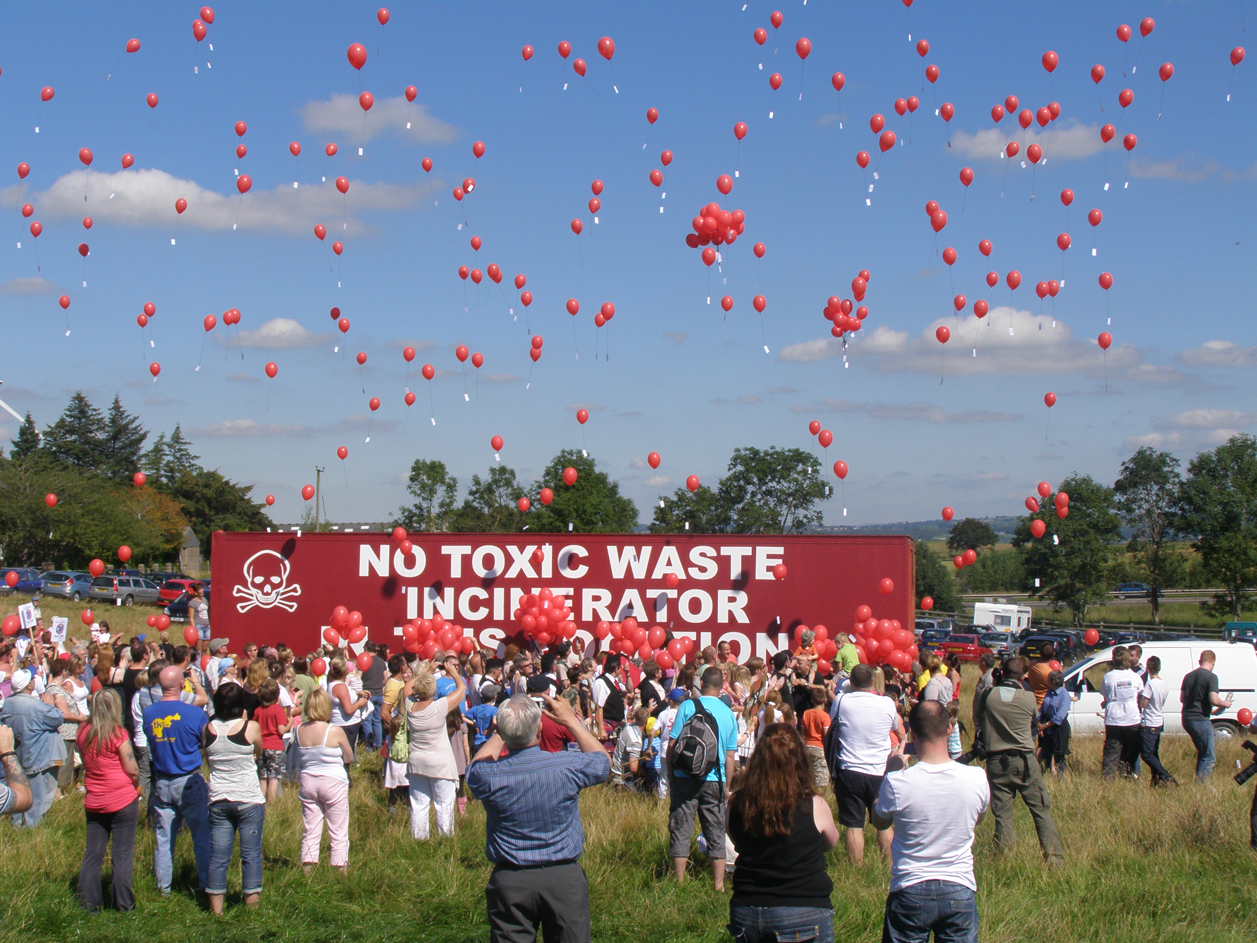
From concerned locals to national change: How Dovesdale Action Group built power and won
In 2010, few people around the village of Stonehouse, South Lanarkshire had a clue about incineration. Yet over the last 13 years, the community has become a hub of resistance to the waste industry’s incineration expansion plans. Together, they have won the fight against several incinerators in Lanarkshire including two at Dovesdale (between the villages of Stonehouse and Blackwood), and helped change national policy to bring in a ban on new incinerators.
The story of how the Dovesdale Action Group built so much power is an inspiring one, and we can learn a lot from how they went from a few concerned locals, to making national change.
I spoke to John Young, one of the members of the Dovesdale Action Group who’s been involved since it began in 2010, to find out more about it.

Incineration is when waste is burned, rather than sending it to landfill. It’s estimated that over 60% of waste from Scottish households burned in incinerators could have been reused or recycled instead, reducing the need to create new fabrics, plastics and metals. When it’s burned, waste produces harmful emissions that contribute to climate change and pollute the local environment. It also leaves behind toxic ash that has to be disposed of. In short: it’s an environmental disaster.
When Viridor submitted an new application for the biggest incinerator in Scotland in Stonehouse in 2021, the Dovesdale Action Group sprung into action once more, having defeated an earlier application at the same site in 2011.
“We were told by everyone involved in this, there’s no way you’re going to defeat a company this size,” says John,. “but what they didn’t know was that we had been preparing.”
In her book Twitter and Teargas, Zeynep Tufecki describes the ability of a social movement to create change as being dependent on the capacity that it can build and signal to those in power. This doesn’t necessarily mean the numbers of people that we can mobilise to protest, especially if that is a one off event and the energy dissipates afterwards. But events like protests can be signals that demonstrate the capacity our movement has to challenge those in power if our demands are not met.
Tufecki describes three main areas where successful movements demonstrate their capacity:
- Narrative – the ability to frame the story in their own terms
- Disruptive – the ability to interrupt business as usual, for instance causing delays to a project
- Electoral – the ability to make their issue a defining factor in whether politicians get elected
When I spoke to John from the Dovesdale Action Group about their long running and highly successful community campaigns, it made me think of this framework as one way to explain how a small community in South Lanarkshire was able to have such a huge impact.
How Dovesdale Action Group took hold of the story
John says that when the first incinerator application was proposed in their area in 2010, it was the fact that the developer only spoke about the positive impacts that made many community members suspicious. When people started researching incineration and the potential impacts, it was the realisation the company wasn’t being honest with them that led to the formation of the Dovesdale Action Group.
The group has, over the past 13 years, commanded the local story about the proposed incinerators with such strength that they have changed the national conversation.
They started out by informing their community about the proposed development and the impacts of incineration. The developers wanted to do the bare minimum regarding community consultation, but the Dovesdale Action Group wanted everyone to know what was happening.
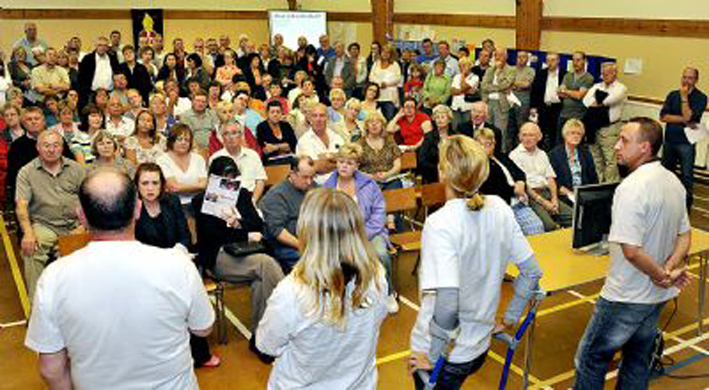
For their two big campaigns, in 2010 and 2021, how they did this looked quite different. In 2010 they relied heavily on in person conversations – holding huge public meetings and chapping doors to make sure everyone knew about the proposed development and their campaign against it. But in 2021, in the midst of the COVID-19 pandemic, a lot of these options weren’t available to them, so they tried other things. They covered the area in big banners and got local businesses to agree to put them up. They also started experimenting with social media and found this was an effective way to communicate with local people, but also those further afield who wanted to support their campaign.
John said they learnt it was important to make their campaign messaging resonate with locals by talking about how it would affect them directly. People were concerned about the height of the incinerator and the eyesore it would create in an area of outstanding natural beauty, as well as the possible impacts on wildlife, local health and the livelihoods of local farmers. They held meetings with local farmers to discuss their concerns and bring them onboard.
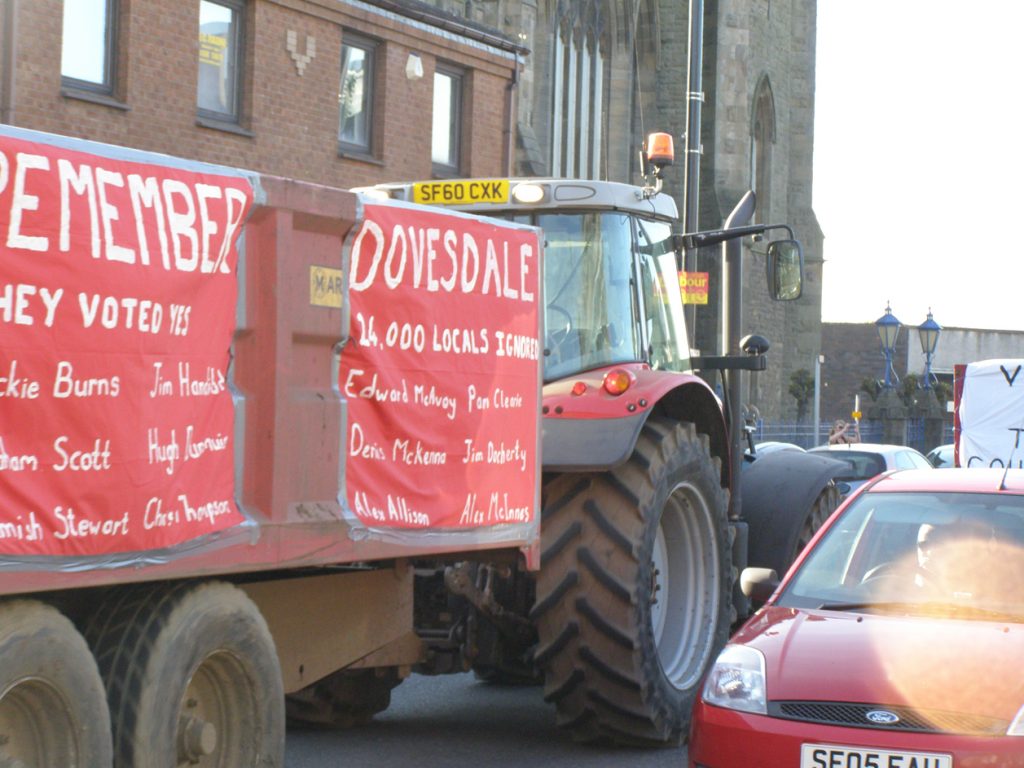
When the 2021 application was submitted, John commented that the change in awareness and concern about climate change was a “game changer”. People recognised that the project wasn’t only going to impact people in Stonehouse, but those across the world already facing the harshest impacts of the climate crisis. He said they went into schools to speak to young people and they already knew about climate change and wanted to help.
They also exposed when the company wasn’t properly consulting or informing the community and repeatedly called them out for greenwashing the project. While the companies were saying that burning waste was a green and renewable project, the Dovesdale Action Group were telling people that the “waste could be a resource. It could be used for the benefit of the country. It’s bad for the planet and the community in which we’re living.” They weren’t pretending to be experts but speaking honestly about how the project would affect them and their community. It resonated, and led to huge public support.
The group also made use of local and national press to set the agenda and keep up the pressure. John said that they had a strategy of drip feeding the issue in the media. They didn’t want one big splash and then for it to fall out of the new cycle – they continuously looked for ways to make this an issue in the press by finding new angles and stories. They reached out to bands and celebrities and even got David Attenborough to support their campaign.
John says that despite being a small community group, they were able to set the conversation and keep up the pressure: “there was a lot we could do with no resources!”
How Dovesdale Action Group delayed the incineration projects
It became clear to the group that there were limited avenues for affected communities to have a meaningful say in applications like these – so they created their own. They started using tactics that showed their ability to disrupt the existing system, causing delays and logistical challenges for the companies, the council and other bodies involved like SEPA, the Scottish Environmental Protection Agency. They forced decision makers to notice and respond to them.
In 2010, they got over 20,000 people to object to the planning application to the incinerator, which was, at the time, the most objections in a planning process anywhere in Scotland. When it was clear they could do that, and they could do it again, they started being taken seriously because institutions knew they had the capacity to cause significant disruption.
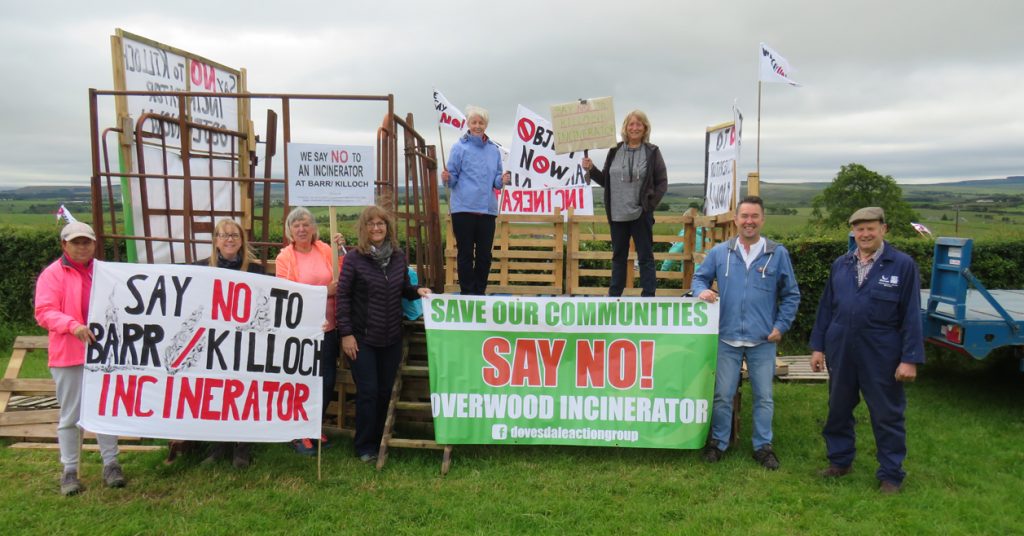
When they announced their ambition to submit 40,000 complaints to SEPA, meaning the organisation would have to respond individually to everyone, they got a meeting with the head of SEPA and Richard Lochhead, the Environment Minister at the time.
“We were bombarding the system and they had to compromise with us to get us to stop”, says John.
The group managed to cause so many delays and barriers to the companies pushing through the incinerator that the projects were withdrawn.
How Dovesdale Action Group showed the issue could influence elections
During the campaign in 2010, the Dovesdale Action Group showed such a strong ability to influence elections, that 10 years later they were taken much more seriously at a local and national level.
When the council initially approved the incinerator application the group decided to target any councillor, across the political spectrum, who supported it. This contributed to several councillors and two MSPs losing their seats.
With this show of power, and through their persistence in writing hundreds of letters and meeting with everyone they could, they were able to sway politicians of all political, persuasion in their favour – not just regarding the latest incinerator site battle, but also on national policy.
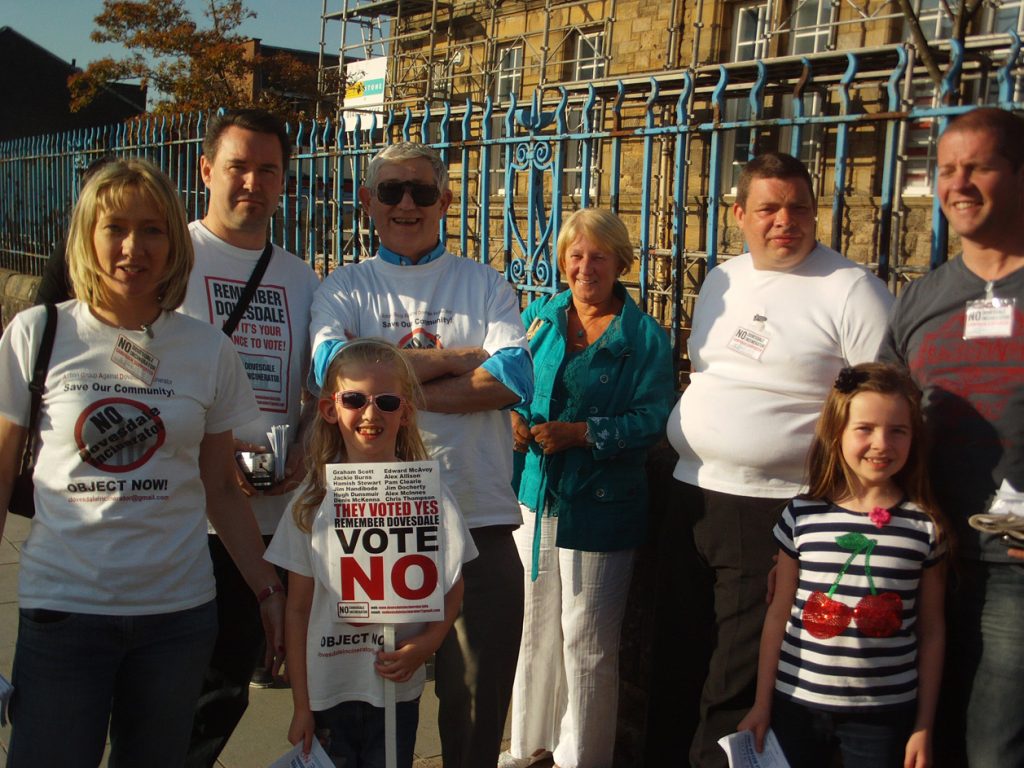
When the application for the Viridor incinerator landed in 2021, the group met and decided that they didn’t want to fight application after application after application – they needed to go for a bigger target. They established a two pronged strategy – to resist the application locally, but to also pressure the Scottish Government to ban incineration altogether through a national review of incineration.
They used the allies and contacts they had built up through years of local campaigning, across several political parties, to intervene in the national debate. They also connected with other organisations who shared this aim – such as Friends of the Earth Scotland and UK Without Incineration Network. They leveraged the 2021 Holyrood election, and the upcoming UN Climate Talks taking place in Glasgow later that year, to persuade the Scottish Greens, the Labour Party and the SNP to include a manifesto commitment to a review of incineration – eventually leading to the ban on new incineration that we have now.
What can other groups learn from their story?
One of the key things that John thinks made the Dovesdale Action Groups campaigns a success was keeping positive about the fact that they could win. They faced a lot of pushback throughout but they made sure in their conversations with each other, and with the public, that if they worked together they could achieve the changes they were aiming for.
They tried lots of different activities, platforms and tactics – adapting to huge challenges like organising through a pandemic. John says that not everything they tried worked, and there are somethings they wouldn’t do again, but it was everything combined that created the pressure they needed to win.
They were also a motivated group, with no one person in charge so others would sit back and think someone else would do everything. They made the most of their different responsibilities and skills, accepting a wide variety of opinions and politics in the group under their one shared aim and this made them stronger.
Scrolling through the Dovesdale Action Groups Facebook group, one of the things I was struck by was the people from other campaigns and communities, from all over the world, commenting that they had been inspired by the tireless work of the communities in Dovesdale.
So often, corporations expect to bulldoze ahead with their plans, regardless of the impact on the local community, the environment and those around the world on the sharpest edge of the climate crisis. They expect that their huge amount of resources, their political access and their expensive greenwash PR will pave an easy road to making whatever destructive project they’re pushing through happen.
The Dovesdale Action Group were told repeatedly that the Viridor incinerator was a done deal and they could never take on one of the biggest waste companies in the UK.
And yet, they stopped the project – one of many incinerators they had successfully resisted – they helped to change national policy and crucially, in John’s words they “gave people a feeling that they could change things”.
John said the campaign made people think “what could we achieve?”
What now for incineration in Scotland?
The Scottish Government committed to banning new incinerators in June last year. In February this year, a government review recommended a ban on sending plastics to incineration, which is the most damaging material to burn. Next, we need them to commit to phasing out the destructive practice altogether.
Incineration is part of a wider problem in Scotland, our linear model of taking from nature and then disposing of things after using them for only a short period (sometimes only once!) We need to move to a circular model, where things are repaired, reused and recycled as much as possible so there isn’t as much waste in the first place.
The Scottish Government will be creating a law that aims to do this this year, and if we grab on to this opportunity, it could be used to rethink the way we source, use and dispose of resources.
The Dovesdale Action Group has shown us the power we have by coming together with tenacity and hope.
